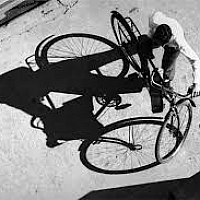
© Thomaz Farkas
Expositions du 17/11/2014 au 10/1/2015 Terminé
Luciana Brito Galeria Rua Gomes de Carvalho, 842 04547 00 São Paulo Brésil
Curated by Sergio Burgi and João Paulo Farkas, Memories and Discoveries intends to exhibit some of the major aspects of Thomaz Farkas's (Budapest, 1924–São Paulo, 2011) work. With the formal experiences in his series "Recortes;" his invaluable records on the construction and inauguration of Brasilia; the delicate boldness of Ballet Russe photographs, in addition to the jewels from his anthological documentary incursion into Brazilian culture, we count on an accurate, and yet representative, overview of one of the most relevant artistic productions in photography and cinema in Brazil.Luciana Brito Galeria Rua Gomes de Carvalho, 842 04547 00 São Paulo Brésil
We are honored to have Farkas among our artists as of 2013, the first time he was commercially represented by a gallery, complementing the outstanding work by Moreira Salles Institute for almost a decade. Perhaps the late insertion of his work to a gallery may be explained by his very nature as a person, a professional, and an artist: multifaceted, and entrepreneurial, all along his life he was much more likely to be himself the one to take the initiative rather than the object of initiatives by others.
We are doubly pleased—having Farkas among our artists not only allows a constant new outlook on his work, but also enhances our presence in Brazilian photography, which is referential in the world, since the legacy of some of Farkas's contemporaries such as Geraldo de Barros and Gaspar Gasparian are also under our representation.
Although belonging to a generation that revolutionized photography art in Brazil and in the world, it is impossible not to recognize that Thomaz Farkas left unique artistic contribution, particularly in representing Brazilian culture—quite faithful to the specificities of the country, but free from regional bias, quite cosmopolitan, and integrated to a bold vision that blends technique, aesthetic experimentation, and documental records.
The definition of a Brazilian identity in domestic cinematography; the incorporation of the country into contemporary artistic turning points; the creation of the scenario so photography could be seen as art (as well as a profession); the opening up of regular spaces for arts in different supports are some of the milestones that counted on Thomaz Farkas's crucial participation. Thomaz Farkas's relevance is as high and as comprehensive as his life was rich with experiences and events. An artist, a photography professor and researcher, movie maker and producer, entrepreneur, cultural agent—the exhibition tries to cover his impressive dynamic character.
This is the first time this legacy is presented without the direct participation of its author. We do hope our inaugural contribution for the understanding of such relevant body of work is a sign for more and more projects that emphasize the place Farkas deserves.

